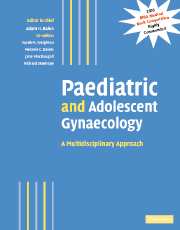Book contents
- Frontmatter
- Contents
- Contributors
- Preface
- Part I Normal development
- Part II Management of developmental abnormalities of the genital tract
- Part III Management of specific disorders
- 18 Disorders of growth and puberty
- 19 Turner's syndrome
- 20 Androgen insensitivity syndromes
- 21 Rokitansky syndrome and other Müllerian anomalies
- 22 The XY female
- 23 The gynaecology of the major genitourinary anomalies
- 24 Congenital adrenal hyperplasia
- 25 Long-term sequelae of genital surgery
- 26 Amenorrhoea
- 27 The polycystic ovary syndrome and adolescent women
- 28 Menstrual disorders in adolescent girls
- 29 Pelvic pain, ovarian cysts and endometriosis in adolescent girls
- 30 Premature ovarian failure and ovarian ageing
- 31 Gynaecological cancers in childhood
- 32 Late reproductive sequelae of treatment for childhood cancer
- 33 Preservation of fertility before cancer therapy
- 34 The management of infertility with surrogacy and egg donation
- 35 Dermatological conditions of the female genitalia
- 36 Vaginal discharge
- 37 Psychological gender development in individuals born with ambiguous genitalia
- 38 Eating disorders in adolescence
- 39 Nutritional amenorrhoea: long-term sequelae
- 40 How to set up a service: how to teach and train
- Index
- Plate section
- References
23 - The gynaecology of the major genitourinary anomalies
from Part III - Management of specific disorders
Published online by Cambridge University Press: 04 May 2010
- Frontmatter
- Contents
- Contributors
- Preface
- Part I Normal development
- Part II Management of developmental abnormalities of the genital tract
- Part III Management of specific disorders
- 18 Disorders of growth and puberty
- 19 Turner's syndrome
- 20 Androgen insensitivity syndromes
- 21 Rokitansky syndrome and other Müllerian anomalies
- 22 The XY female
- 23 The gynaecology of the major genitourinary anomalies
- 24 Congenital adrenal hyperplasia
- 25 Long-term sequelae of genital surgery
- 26 Amenorrhoea
- 27 The polycystic ovary syndrome and adolescent women
- 28 Menstrual disorders in adolescent girls
- 29 Pelvic pain, ovarian cysts and endometriosis in adolescent girls
- 30 Premature ovarian failure and ovarian ageing
- 31 Gynaecological cancers in childhood
- 32 Late reproductive sequelae of treatment for childhood cancer
- 33 Preservation of fertility before cancer therapy
- 34 The management of infertility with surrogacy and egg donation
- 35 Dermatological conditions of the female genitalia
- 36 Vaginal discharge
- 37 Psychological gender development in individuals born with ambiguous genitalia
- 38 Eating disorders in adolescence
- 39 Nutritional amenorrhoea: long-term sequelae
- 40 How to set up a service: how to teach and train
- Index
- Plate section
- References
Summary
Introduction
There are three congenital genitourinary anomalies that have a serious impact on female sexual and reproductive function: exstrophy, spina bifida and the cloacal anomalies. It is true that spina bifida is primarily a neurological condition, but in practice it is the urological complications that dominate childhood and adolescence. The urologist usually manages the overall care.
Classical exstrophy has been recognized for about 2000 years and has been the subject of voluminous surgical literature since the middle of the last century. The results of exstrophy reconstruction, both functional and cosmetic, have improved considerably since the 1980s. The present adult women who were born with exstrophy would usually have had an early diversion and, if they wished, a continent reconstruction when such surgery became available. Few of them would have had a reconstruction that allowed them to void naturally and fewer still will have maintained that ability into their third decade (Woodhouse and Redgrave, 1996). Now, in specialist centres, primary reconstruction is undertaken in the first hours of life. Continence and spontaneous voiding are the norm; reconstruction with intestine and intermittent clean self-catheterization (ICSC) are sometimes needed.
With this general improvement has come the realization that exstrophic patients grow up and want to work, marry and have children. Exstrophy is an isolated anomaly in otherwise normal children. They grow up normally and, anecdotally, are intelligent and well-motivated adults.
- Type
- Chapter
- Information
- Paediatric and Adolescent GynaecologyA Multidisciplinary Approach, pp. 293 - 309Publisher: Cambridge University PressPrint publication year: 2004
References
- 1
- Cited by



